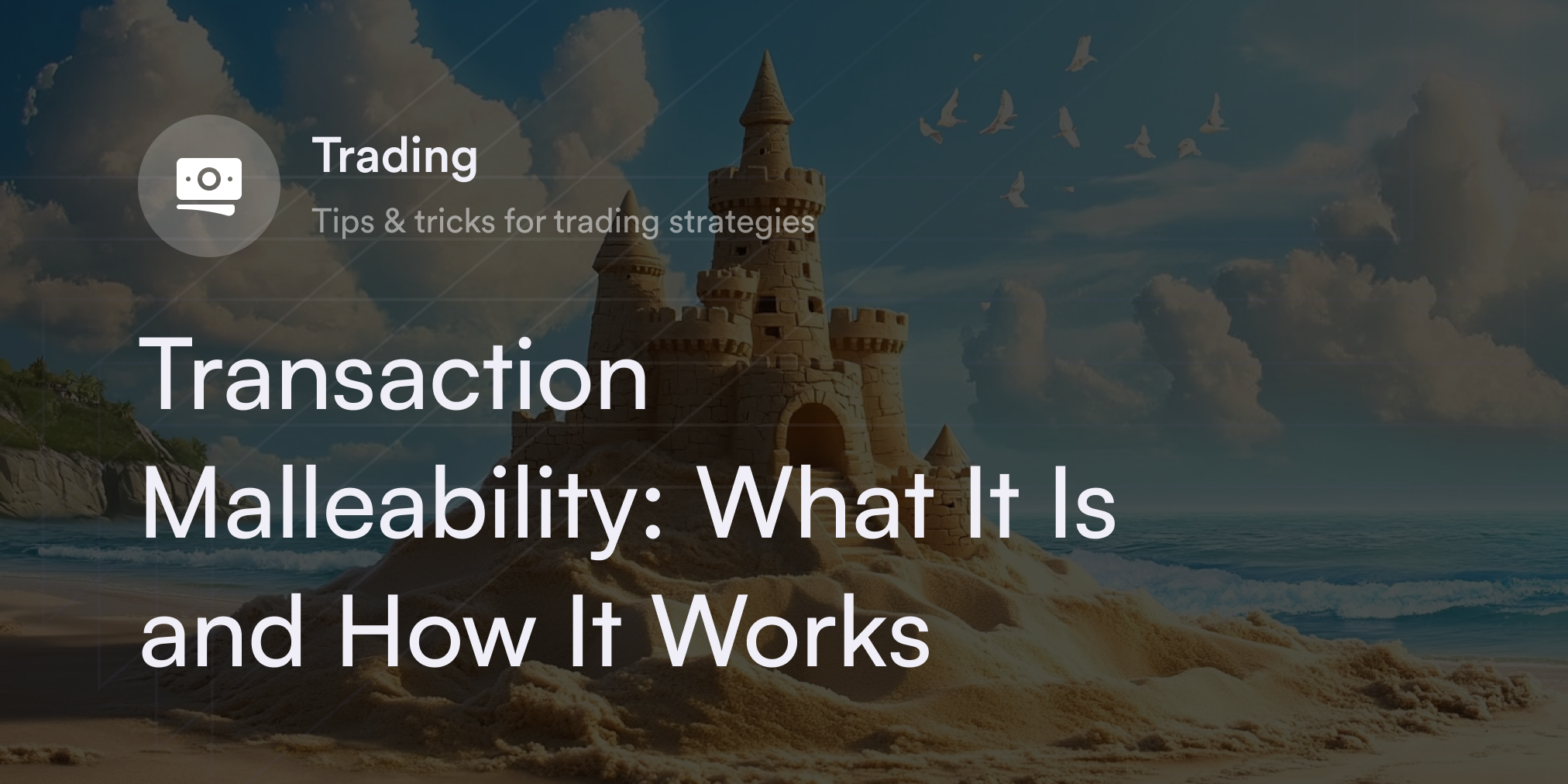


Soon after Bitcoin's (BTC) successful launch in 2009, cryptocurrencies transformed from an experiment in peer-to-peer (P2P) digital payments to a globally recognized market valued at more than $1 trillion. Although many people have yet to embrace cryptocurrency, many already own it. In fact, an increasing number of crypto exchanges, apps, and online protocols are working on making it simpler for traders to explore the crypto ecosystem.
Given the growing demand for and accessibility of cryptocurrencies, it's no surprise more people are curious about trying their hand at trading crypto positions for a profit. While trading cryptocurrencies presents many unique and exciting opportunities, it doesn’t come without risks.
When starting as a crypto trader, establishing clear market objectives and techniques to achieve profit goals is essential. With predefined crypto trading strategies, you can easily assess risk and decide how, when, and what positions to open in the digital assets market. Here are some basics for you to understand before starting your trading journey.
What is Crypto Trading?
When people say they're trading cryptocurrencies, they’re referring to buying and selling virtual tokens or coins, attempting to make a profit. Crypto trading also includes opening and closing positions in assets related to the cryptocurrency sector, including financial products like shares in crypto companies, Bitcoin ETFs, or crypto index funds.
Like any other asset, you need strong crypto trading strategies to enter and exit the crypto market in pre-established timeframes. When building your crypto strategy, start by defining when and how you want to buy cryptocurrencies according to your preferred risk tolerance. For example, if you’re a short-duration trader, calculate your desired return and maximum loss potential before setting the price levels where you want to take profits or cut losses.
Active Trading Versus Passive Trading: The Key Differences
There are two types of trading: active and passive. Understanding both is vital before participating in the crypto economy.
The critical feature separating active and passive crypto traders is how often they adjust their portfolios. When you actively manage your crypto account, you regularly buy and sell positions in response to market conditions. For example, crypto day trading involves opening and closing cryptocurrency trades within 24-hour periods, while swing trading includes holding crypto positions for a few days or weeks.
Active crypto traders aim to outperform the price of holding cryptocurrencies like Bitcoin or Ethereum (ETH) by taking advantage of short-term price fluctuations. Although making money using an active approach is possible, you must factor in the extra time, fees, and stress associated with this technique. Also, you should determine how to deal with potential losses when setting up trades in case your price thesis doesn't pan out.
In contrast, passive crypto trading takes a hands-off approach to buying and selling. Since the passive strategy usually involves holding crypto assets for multiple months or years, with the hope that upon the later sale of the asset, the value will be higher than when purchased.
A passive strategy has a lower time commitment, less stress, and fewer trading fees than active trading. But passive techniques don't deliver traders their expected returns and take longer to assess the performance of these portfolios. Short-term traders know exactly how much they gained or lost once a position closes, but it takes years to monitor the performance of a passive account.
Spot Versus Derivatives Crypto Strategies: Different Ways to Trade Crypto
When developing Bitcoin trading strategies, traders either buy spot digital assets or derivative products (if they are in a jurisdiction that permits).
A spot market is any crypto trading platform offering traders direct access to digital assets like Bitcoin, Ethereum, and other altcoins. For example, when a trader sets up a spot account on an exchange like Coinbase, they can exchange cash for cryptocurrencies and transfer their crypto assets to a private wallet.
Crypto derivatives, conversely, are synthetic contracts mirroring the value of digital coins or tokens. When eligible crypto traders exchange derivatives, they can speculate on a cryptocurrency’s future value without holding the underlying assets themselves. Options are one form of crypto derivatives that give holders the right to buy or sell a cryptocurrency at a specific price by a particular date. Other types of crypto derivatives are futures and forward contracts, which require traders to buy or sell digital assets at an agreed-upon rate at expiration.
Pros and Cons of Crypto Trading
Day trading cryptocurrencies is an exciting opportunity for people interested in cutting-edge technology and finance, but it's not an ideal option for every trader. Before opening a crypto exchange account, consider the benefits and risks of adding digital assets to your portfolio.
Pros of Crypto Trading
Substantial growth opportunities: Despite the rising adoption of coins like Bitcoin and Ethereum, cryptocurrency is one of the newest markets in the global financial system. The relatively small size of the crypto market gives it great potential upside if more citizens, companies, and countries adopt decentralized digital payments.
Self-custody over digital assets: Buying spot cryptocurrencies lets you put your digital assets in a secure self-custodial crypto wallet and take ownership of your virtual property. There's no need to rely on third-party intermediaries like banks or brokers to watch over the BTCs in your wallet, enabling you to use and store your digital funds as they deem fit.
Many ways to trade cryptocurrency: You aren't limited to buying and holding cryptocurrencies in a private wallet. Although buying on the spot market is popular, dozens of other crypto-related products and services are available to set up dozens of positions. From derivatives like options and perpetuals to crypto index funds and ETFs, you have plenty of ways to build portfolios per your preferences.
Exciting opportunities in Web3: The term Web3 refers to internet applications built using blockchain rather than corporate-controlled cloud servers. With a crypto wallet and digital funds, you can use your crypto assets to explore countless new income opportunities in fields like decentralized trading, staking, and crypto lending.
Cons of Crypto Trading
Suits high-risk traders: As one of the newest and most experimental asset categories, cryptocurrencies tend to have volatile and unpredictable price movements. While cryptocurrency’s price volatility offers tremendous potential upside, it increases the odds of sizable losses. If buying into this market, you should adjust to crypto’s wild price swings.
Lacks broad diversification: Although many niches exist in the cryptocurrency space, digital assets use blockchain technology to power their networks. So buying any cryptocurrency is a bet on blockchain’s future, making it challenging to create a truly diverse portfolio.
Involves a steep learning curve: Cryptocurrency exchanges are creating more user-friendly interfaces to help novice traders, but buying and transferring crypto assets still requires a bit of technical know-how. Learn new skills like how to transfer digital assets and upload crypto wallets to control your crypto holdings. Also, note that if you hold your digital assets in a private wallet, you’re responsible for securing your funds.
Prone to scams and hacks: There have been many high-profile hacks and scams in the history of cryptocurrency, with bugs and exploits still harming the industry. Even if you arm yourself with safety tips, there's always a chance of a hack, especially when using more experimental protocols like crypto bridges.
What are the Most Popular Crypto Trading Strategies?
Although there are countless ways to set up personalized crypto strategies, a few widely practiced techniques exist in the crypto market. Sometimes, people combine multiple trading methods to achieve their desired results. Here are five to consider:
HODL
First introduced in 2013, HODL is a meme, passive trading strategy, and an acronym for “hold on for dear life.” People who HODL their cryptocurrency keep it in a private wallet for years and wait for it to appreciate before selling. Thanks to its simplicity and popularity on social media, HODL remains one of the most prominent Bitcoin trading strategies for people with a long time horizon.
Dollar-Cost Averaging (DCA)
DCA means consistently buying small amounts of cryptocurrency at set timeframes (e.g., once a week) or when a digital asset falls by a specific percentage in a daily trading session. The goal is to even out your average purchase price and curb the cryptocurrency market's volatility. People often combine DCA with HODL for a long-term passive approach to the crypto market.
Technical Trading
Technical analysis is a branch of market research focusing on crypto chart patterns to predict future prices for digital assets. Traders who use this method rely on indicators like moving average trendlines, the relative strength index (RSI), and Bollinger bands to pinpoint critical price levels and set up crypto day trading strategies.
Arbitrage
An arbitrage day trader (or arbitrageur) looks for opportunities to simultaneously buy and sell a cryptocurrency on two or more exchanges to profit from market inefficiencies. For example, if Bitcoin trades on the exchange Kraken slightly below the market price on Gemini, arbitrageurs buy large amounts of BTC on Kraken and sell it on Gemini for a quick profit. Often, arbitrage traders use advanced algorithms like high-frequency trading programs (aka bots) to detect and execute these trades at lightning-fast speeds.
Margin Trading
Margin trading involves borrowing funds against collateral to buy and sell cryptocurrencies. Using margin services allows you to quickly boost your position size and increase potential profit, but it exposes you to increased losses if your trade doesn't turn out as expected. It’s recommended to understand the high risks of this method and take proper precautions like using stop-losses before trading.
Eligible Traders can Experience the Best Crypto Perps Trading on dYdX
dYdX is the premier decentralized exchange to trade cryptocurrency perpetual contracts. After linking a crypto wallet on dYdX's platform, eligible traders can open and close positions on dozens of crypto assets, including major coins and tokens like Bitcoin, Ethereum, and Cardano (ADA).
For more details on the products and services on dYdX's exchange, check out our official blog for the latest updates. Also, visit dYdX Academy for more pro tips on trading crypto and exciting tools and opportunities in Web3, and eligible traders can start trading on dYdX today.
Disclaimer
The content of this article (the “Article”) is provided for general informational purposes only. Reference to any specific strategy, technique, product, service, or entity does not constitute an endorsement or recommendation by dYdX Trading Inc., or any affiliate, agent, or representative thereof (“dYdX”). Use of strategies, techniques, products or services referenced in this Article may involve material risks, including the risk of financial losses arising from the volatility, operational loss, or nonconsensual liquidation of digital assets. The content of this Article does not constitute, and should not be considered, construed, or relied upon as, financial advice, legal advice, tax advice, investment advice, or advice of any other nature; and the content of this Article is not an offer, solicitation or call to action to make any investment, or purchase any crypto asset, of any kind. dYdX makes no representation, assurance or guarantee as to the accuracy, completeness, timeliness, suitability, or validity of any information in this Article or any third-party website that may be linked to it. You are solely responsible for conducting independent research, performing due diligence, and/or seeking advice from a professional advisor prior to taking any financial, tax, legal, or investment action.
You may only use the dYdX Services in compliance with the dYdX Terms of Use available here, including the geographic restrictions therein.
Any applicable sponsorship in connection with this Article will be disclosed, and any reference to a sponsor in this Article is for disclosure purposes, or informational in nature, and in any event is not a call to action to make an investment, acquire a service or product, or purchase crypto assets. This Article does not offer the purchase or sale of any financial instruments or related services.
By accessing this Article and taking any action in connection with the information contained in this Article, you agree that dYdX is not responsible, directly or indirectly, for any errors, omissions, or delays related to this Article, or any damage, injury, or loss incurred in connection with use of or reliance on the content of this Article, including any specific strategy, technique, product, service, or entity that may be referenced in the Article.







